
By Lucia Adams
When I booked an Amtrak Vacation to Glacier National Park everyone was envious, “I’ve always wanted to take a long train trip.” Well, I had many years ago but it was the Orient Express, so full of hope I reserved a roomette for two, quite costly considering, including three nights in Glacier Park Lodge in the most beautiful park in America. 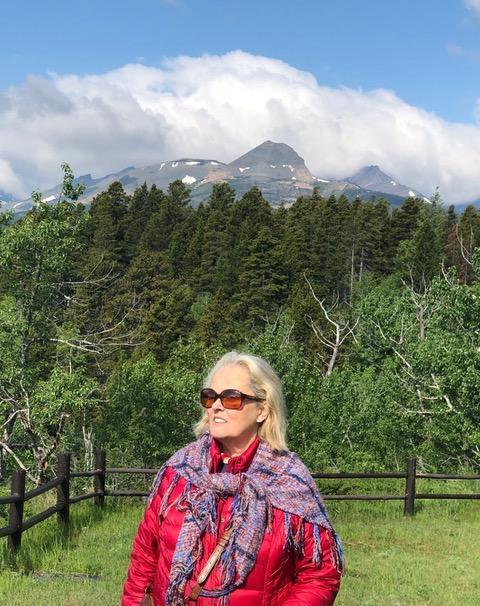
On the first day of summer The Empire Builder left Union Station, late, at 3 p.m. for Seattle our final stop northwest Montana a few miles from Waterton, Alberta. With long hours of daylight on the Summer Solstice we arrived in North Dakota with its one-stoplight towns like Malta and Glasgow (where a large family of Amish from Indiana detrained). Atop the Bakken formation‘s mammoth oil reserves discovered in 1953, we sped past glacial drumlins and kettle moraines, oil tanks and grain elevators on the old Burlington Northern tracks.

Burnt trees and bear grass.
Our “superliner” sleeping car, launched in 1979 and purportedly upgraded in 2005, looked its age. After hoisting a heavy suitcase up a tiny cast iron step onto the train (no redcaps here!) the Oh Nos began; the roomette was far too small for two people who had to sit stone cold upright, knee to knee. I begged a disconsolate attendant for an upgrade to a bedroom for an extra thousand but no-go though several were empty. We made for the somewhat dingy observation car, first come, first serve musical chairs style and at 6 p.m. gloomily headed to the dining car. No North by Northwest here, just tubby strangers squeezed in next to us for pre-prepared airplane food. We avoided the mussels like grim death. Thus commenced The Struggle for Sleep: the top bunk was extremely dangerous to ascend without a ladder (there was none) and Jack had to use the tiny armrest and bolt up onto the lurching mat. How is it up there? Pitch Black. Can’t Turn Over. Afraid I’ll fall out. The lower hard cot was not much better; the loos, smaller than an airplane’s, were down a long flight of stairs. Don’t ask about the lone shower. Upgrade wouldn’t even begin to do it. You need new cars. Period.
More than thirty long hours and 1,500 miles later what a relief to get out of there into the fresh air of the northern Rockies and to walk across the tracks to the red cedar lodge which opened in 1913 three years after the park itself. Though in obvious need of renovation it was impressive with 48-foot high three-story Douglas-fir colonnade in the lobby though the rooms had not altered in a hundred years and were freezing in the 40 degree weather.
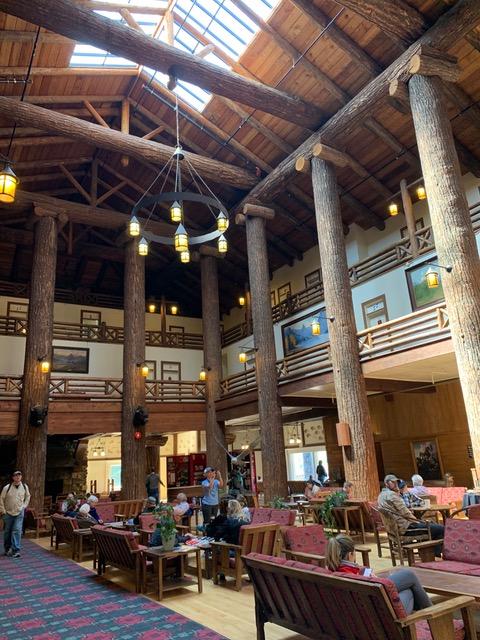
The lodge sits on the sovereign land of the Blackfeet Nation, Algonquin speaking Piegan people who have lived here for 10,000 years. As on all of the 310 Native American reservations in the country, the judgments of American courts cannot be enforced in a well-intentioned but obsolete system that has perpetuated poverty and welfare dependents — full blood, half blood and “wannabees” according to our Blackfoot guide Kammi. It is difficult to get bank accounts or credit since the nation does not honor American contracts so she was saving up tips to put a tin roof on her bungalow. Land is held communally; everyone owns it so in effect no one does and they can’t get clear title to the land and collateral from their mobile homes.
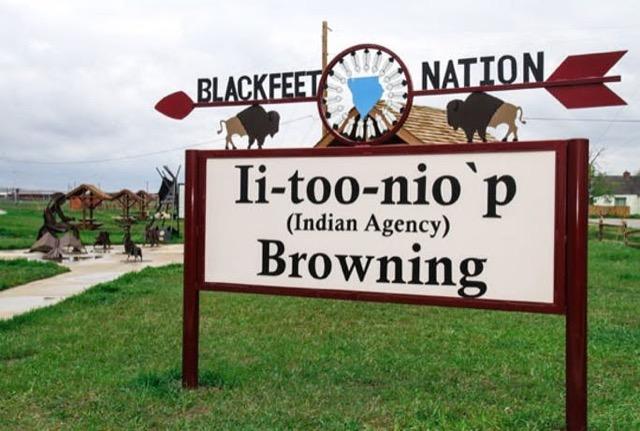
Kammi, one of the 16,000 members of the tribe, is a firefighter on the Hotshot Team that battled the 2006 conflagration of 64,000 acres on Red Eagle Mountain that will take 40 years to recover. She lives in Browning the headquarters of the 3,000 square mile reservation, a desolate trailer park of ramshackle dwellings with rusted cars just like the ones we saw last year in Wyoming, with rampant alcoholism, (Kammi said if you give a buck a can of beer he’ll disappear for a week), a high crime rate and 80% unemployment. There is a small casino next to a Holiday Inn with 300 slot machinea and a bingo parlor but the money does not filter down to the people. Tribal reform is needed and Chief Old Earl Person the 90 year old legend from Browning is still lobbying for indigenous people rights in D.C. John Two Guns White Calf (1872-1934), who is memorialized in profile on the American buffalo nickel is buried in Browning.
 Melting glacier.
Melting glacier.
Glacier National Park has a million acres of forests, alpine meadows, lakes, 150 rugged peaks (many 10,000 feet) and glacier-carved valleys; sadly only 25 rapidly melting remain of the 200 a few decades ago. We joked, “They should call it Melting Glacier National Park.” This vast pristine “Crown of the Continent Ecosystem,” now includes some 300 buffalos which were wiped out in 1890 but a few years ago the Blackfeet imported some from Canada. We saw one baby mountain goat but no bears or grey wolves, though hikers were warned that a big grizzly was stalking hikers, their bear spray of no use. 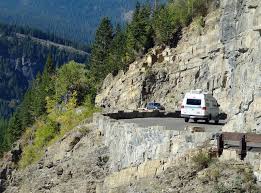 Going to the Sun road.
Going to the Sun road.
We took a boat ride on one of the eight deep water glacial lakes the sacred Badger Two Medicine Lake in mist, then rain, then descending fog past cascading Aster Falls, on the Continental Divide. The next day Kammi drove for eight hours up the vertiginous narrow, winding, impossibly steep 50 mile highway, built in 1930, the Going- to- the- Sun Road (there being no Blackfoot word for west) and reached the highest point in the park, Logan’s Pass where the impenetrable downpour forced us had to turn back. The road was steep with sharp drop offs and tiny stone barriers that made the Amalfi coast road look spacious. It was too dangerous to proceed downhill to the west side of the park past Never Laughs Mountain and No Name Lake to Apgar Village.
 Rainy day on Going to the Sun Road.
Rainy day on Going to the Sun Road.
In the front seat l could not see the yellow line and was imagining headlines, “SUV falls 10,000 feet into gorge killing all.” (A car fell just there a few days ago). Despite the peek- a- boo weather back past Babb and St. Mary’s there were breathtaking mountain vistas and the scale of the starkly empty glacial landscape was such a contrast to lush Yellowstone! Four soaking wet middle aged back country hikers waved us down desperate to get a ride back into town since the ranger service not operating for another week. Kammi said she would send some emergency vehicles.
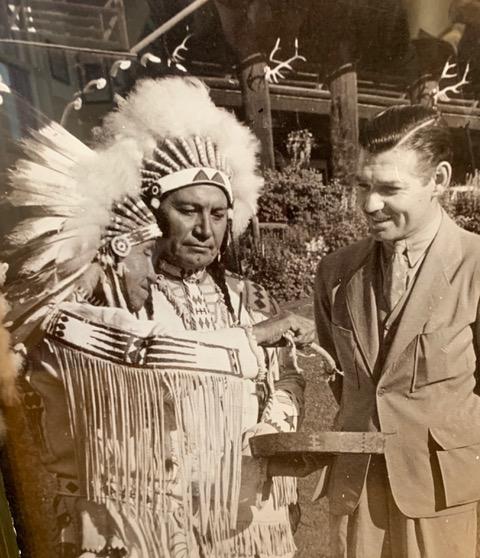 Clark Gable and Theodore Lost Foot 1931, Glacier Train Studios.
Clark Gable and Theodore Lost Foot 1931, Glacier Train Studios.
The return journey was predictably uncomfortable, sleepless and starchy and when we arrived, late naturally, back at Union Station, I vowed, to the cheers of cynical Amtrak employees, to write to CEO Richard Anderson. The former head of Delta has been so focused on profit and the bottom line since 2017 that he has sadly neglected our national long distance network routes; in fact he intends to break up these routes completely in favor of Northeast corridor commuter lines, “we’re not here to run a museum.” He has a lot to answer for to the American people.






